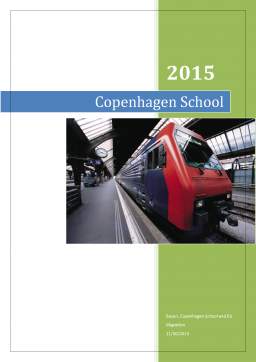Extras din referat
Introduction
Confusion? Economic failure? Human rights and protection? Fighting for survival? Do we know the answers to these problems? Can we offer a practical solution? Tensions in the European Union (EU) have started in 2014, when conflicts, civil war, pervasive poverty, poor economic conditions and lack of opportunities have escalated across a number of countries (i.e. Syria, Afghanistan, Iraq, Kosovo, Albania, Pakistan, Eritrea, Nigeria, Serbia, Ukraine etc.) Furthering the work of Barry Buzan on the Copenhagen School and the question of security, I intend to offer an insightful critique on the securitization of the Euro zone. I will apply critical theory, securitization theory and further the knowledge of language theory, pursuing to understand EU’s response to inward migration. In this application, some of the responses were the revision of policy areas, reduction in incentives for illegal migrants, saving lives and securing external borders, creating a strong asylum policy and one for legal migration. Idealistically thinking, but sharing structural realist assumptions of Buzan, I engage with some country’s rules and norms regarding asylum seekers and refugees. On the last point, I will offer a few other linked ‘problems’ associated with the crisis and how can we overcome them, if there is any chances to do so.
Barry Buzan and the Copenhagen School
The framework of security is very narrow. This is due to three concepts: the ‘form of act’, the ‘context’ and the ‘nature’ of the act. The ‘form’ is defines thought speech of the dominant world actors. The context focuses only on the after intervention. The nature is seen always in terms of threats. Wæver (2004) points out the main concern of the Copenhagen School which is securitisation defined in terms of security threats. The conditions and the audience of the speech act are under-theorised so they remain outside the framework. The main questions and dynamics of security are far beyond reach and so they are neglected. According to Barry Buzan, securitization is contrasted on particular issues as being security issues. But how does one determine what consists a security threat? (Buzan and Wæver, 1998): Security: A New Framework of Analysis. Weaver points out the ‘speech act’, referring to the language used to define security threats. The audiences play a very significant role into ‘backing up’ these speech acts. So, speech acts have transformed from production of security to construction of security. (EU speech acts).
Since 2001, it has been noted that immigrants and asylum seekers threaten the sovereignty and identity of these ‘liberal nation-states’.
Securitisation can be approached at different levels (Buzan et.al, 1993). These can include: the political, the economic, the military, the societal and the environmental sectors, (Box: 1.1). ‘”Security” is the move that takes politics beyond the established rules of the game and frames the issue either as a special kind of politics or as above politics. Securitization can thus be seen as a more extreme version or as above politics’ (Buzan, Wæver and de Wilde, 1998: 23). So, it is an operation which takes place within the political system (Albert and Buzan, 2011). Politicians tend to form discourses, what the Copenhagen approach would call ‘speech acts’. These discourses would transform from the production of security at state level, to the construction of security at the international level. He offers a very comprehensive representation of the speech act. He says that ‘issues become security issues though language’ (McDoanld, 2008). Sometimes, security issues are not only expressed though language, but images. In this case, the leaders of the speech acts are not state leaders or politicians, but artists and the media.
Bibliografie
Baldwin, D. A. ‘The Concept of Security’, Review of International Studies, 23 (1997) pp. 5-28.
Buzan, B. and Wæver, O. (2003), Regions and Powers: The Structure of International Security: Cambridge, Cambridge University Press.
Buzan, B., Wæver, O. and Wilde, J. (1998), Security: A New Framework for Analysis: London, Lynne Rienner.
Buzan, B. (1991), People, States and Fear: An Agenda for International Security Studies in the Post-Cold War Era, 2nd ed.: London, Harvester Wheatsheaf.
Smith, S. (2005), ‘The Contested Concept of Security’, in Critical Security Studies and World Politics, edited by Ken Booth: London, Lynne Rienner, pp. 27-62.
Buzan, B. and Hansen, L. (2007), Chapter 7:’Widening and deepening security’ in The Evolution of International Security Studies: Cambridge, Cambridge University Press, pp. 187-225.
Buzan, B. and Albert, M. (2011). Securitization, Sectors and Functional Differentiation. Paper for panel 5/stream 7 at the ISA Asia-Pacific Region Inaugural Conference Brisbane
Diskaya, A. (2013). ‘Towards a Critical Securitization Theory: The Copenhagen and Aberystwyth Schools of Security Studies’.
McDonald, M. (2008). ‘Securitisation and the Construction of Security’. University of Warwick.
Oradau, C.(2010). Security That Matters: Critical Infrastructure and Objects of Protection. Security Dialogue. Vol 41, nr.5 pp.491-519.
Stone, M. (2009). Security According to Buzan: A Comprehensive Study Analysis: Paris, France.
Squire, V. (2009). The Exclusionary Politics of Asylum: The Open University, United Kingdom.
Šulović, V. (2010). ‘Meaning of Security and Theory of Securitisation’. BSCP Intern.
http://ec.europa.eu/eurostat/statistics-explained/index.php/Migration_and_migrant_population_statistics#Migration_flows
http://www.bbc.com/news/world-europe-34131911
http://ec.europa.eu/priorities/migration/docs/migration-1-year_en.pdf
http://www.bbc.com/news/world-europe-24583286
Preview document
Conținut arhivă zip
- Copenhagen School.docx
















